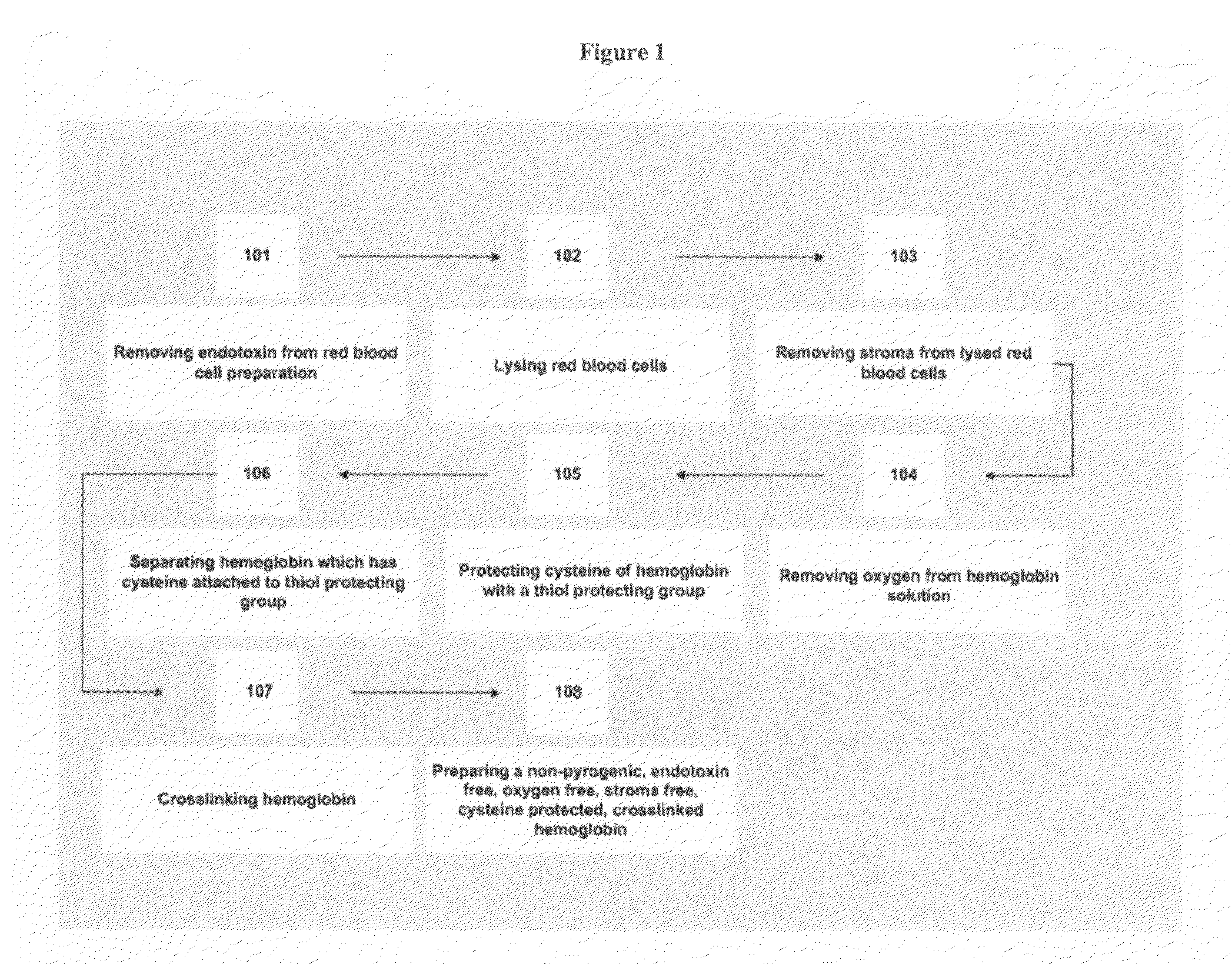Nitric oxide-blocked cross-linked tetrameric hemoglobin
- Summary
- Abstract
- Description
- Claims
- Application Information
AI Technical Summary
Benefits of technology
Problems solved by technology
Method used
Image
Examples
example 1
Comparison of Two Methods of Initial Processing of Whole Blood
[0212]Materials: Bovine Blood Collection: Bovine blood is collected in a 1 gallon collection container which may hold 100 ml of 6% sodium ethylenediaminetetraacetic acid (EDTA) solution and is cooled in ice.
[0213]The whole bovine arterial blood is divided into Batch A and Batch B. Batch A consists of 2200 ml of whole blood and is washed in the haemonetics Cell Saver 5 to obtain concentrated red blood cells free of platelets, clotting factors, extra cellular potassium, anticoagulants, and cell stroma (Method A). Batch B consists of 1800 ml of whole blood and is washed on a Millipore 0.65 μm filter (Method B).
[0214]Method A. Cell Saver 5 removal of plasma proteins: Cell Saver 5 from Haemonetics is used to concentrate erythrocytes from other components in freshly collected anticoagulated bovine blood. It may be desirable not to fracture either leucocytes or erythrocytes at this point.
[0215]After being passed through a coarse...
example 2
Lysing White Blood Cells
[0224]Determination of the relative time of lysing of WBCs is demonstrated. Preferential lysing of RBCs relative to WBCs allows optimization of red blood cell lysis to obtain the maximum amount of hemoglobin, without also introducing proteases from lysed WBCs.
[0225]Procedure: 2000 mls of whole blood is filtered through only the 100μ reservoir filter of the Cell Saver 5. Seven beakers are then filled with 200 mls of blood. One beaker is designated as the control. The other six beakers are then assigned a specific time for lysing at times of 30 seconds and then 1, 2, 3, 4, and 5 minutes. The control beaker is started and 910 mls of 0.9% saline solution is added. At time increments of 30 seconds, 1, 2, 3, 4, and 5 minutes a 10 ml sample is taken for white blood cell analysis.
[0226]For the remaining six beakers, 800 ml of DI water is added. After 30 seconds 110 ml of 9% saline is added to the first beaker to stop lysing. After being allowed to stir for approximat...
example 3
Rabbit Safety Trial
[0228]MATERIALS: Domestic rabbits are raised and treated by standard animal husbandry. IV access is established with a 22 or 24 gauge catheter into a shaven topically anesthetized ear vein for dXCMSFH infusion. IV infusion is metered with a syringe pump; the total volume usually given over 45-60 minutes. If blood is removed from rabbits, it is performed by inserting a 20-22 gauge catheter into the artery of the other ear. Procedures and infusions are done using a Velcro cloth wrap type restraint.
[0229]METHODS: Protocol A: Rabbits are prepared for infusion as above. dXCMSFH to be administered has a p50 for O2 of 28-32 as determined on a TCS Hemox-Analyzer at 37° C. in pH 7.40 buffered NS, and is 12% w / v for the modified hemoglobin of the invention. The amount of dXCMSFH to be infused is based upon 10% of the estimated blood volume of a rabbit (56 ml / kg). This amount is placed into the syringe, and infused by the pump over 45-60 minutes. The IV catheter is then remo...
PUM
| Property | Measurement | Unit |
|---|---|---|
| Mass | aaaaa | aaaaa |
| Mass | aaaaa | aaaaa |
| Volume | aaaaa | aaaaa |
Abstract
Description
Claims
Application Information
 Login to View More
Login to View More - R&D
- Intellectual Property
- Life Sciences
- Materials
- Tech Scout
- Unparalleled Data Quality
- Higher Quality Content
- 60% Fewer Hallucinations
Browse by: Latest US Patents, China's latest patents, Technical Efficacy Thesaurus, Application Domain, Technology Topic, Popular Technical Reports.
© 2025 PatSnap. All rights reserved.Legal|Privacy policy|Modern Slavery Act Transparency Statement|Sitemap|About US| Contact US: help@patsnap.com



